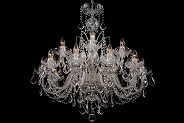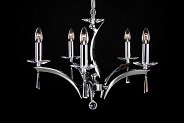Czech Crystal Chandeliers
Czech glass is a very famous concept. Archaeological discoveries have confirmed the existence of glass production in Czech countries since the 9th century. Discoveries in Northern Bohemia (Jablonec in particular) together with bills of sale support the hypothesis that glassworks existed there from the mid-14th century.
Czech glass is a symbol of quality, craftsmanship, unique style, beauty and also low prices. It became a sought-after product and dominated the European market since the 17th century. Pure colourless glass called "Czech crystal" produced at that time in Bohemia was ideal for engraving and cutting and it was superior to other crystal glass for more than one century. A hundred years later it was discovered that adding lead oxide markedly improved the crystal's optical qualities. That is how leaded crystal originated and spread all over the world.
In 1724, the glass cutter Josef Palme obtained a royal warrant for chandelier production. The first workshop used for manufacturing chandeliers was founded in a small village of Prácheň near the city Kamenický Šenov in Northern Bohemia. Czech crystal chandeliers were very popular in Europe until the mid-18th century and they influenced development and style of future chandeliers all over the world.
Look at the beauty of LUCKY GLASS chandeliers hanged in real interiors to make sure it is not just a part of history.
Czech crystal chandeliers were also sought-after by the aristocracy. The palaces of the French king Louis XV, the Austrian Empress Maria Theresa and the Russian Czarina Elizabeth were ornamented with the original, perfect Palme’s chandeliers. Czech crystal chandeliers were a sign of good taste, wealth and nobility and they became as prestigious as expensive jewellery. The glitter of Czech crystal chandeliers enhances the brilliance of castles and palaces; it illuminates parliaments, governmental residences, universities, concert halls, cathedrals and sanctums across the globe. For instance, Czech crystal chandeliers hang in Milan's La Scala, Rome's Royal Opera, in Versailles, in the Hermitage Museum in Saint Petersburg and in the residence of King Ibn Saud in Riyadh.
Czech crystal chandeliers are deservedly called "crystal sun" – a sun which never sets and forever remains the jewel in the crown of the Czech glass art.
More information about Czech glass
Would you like to know more about Czech glass, its history and our chandelier production technology? More information on these pages:







